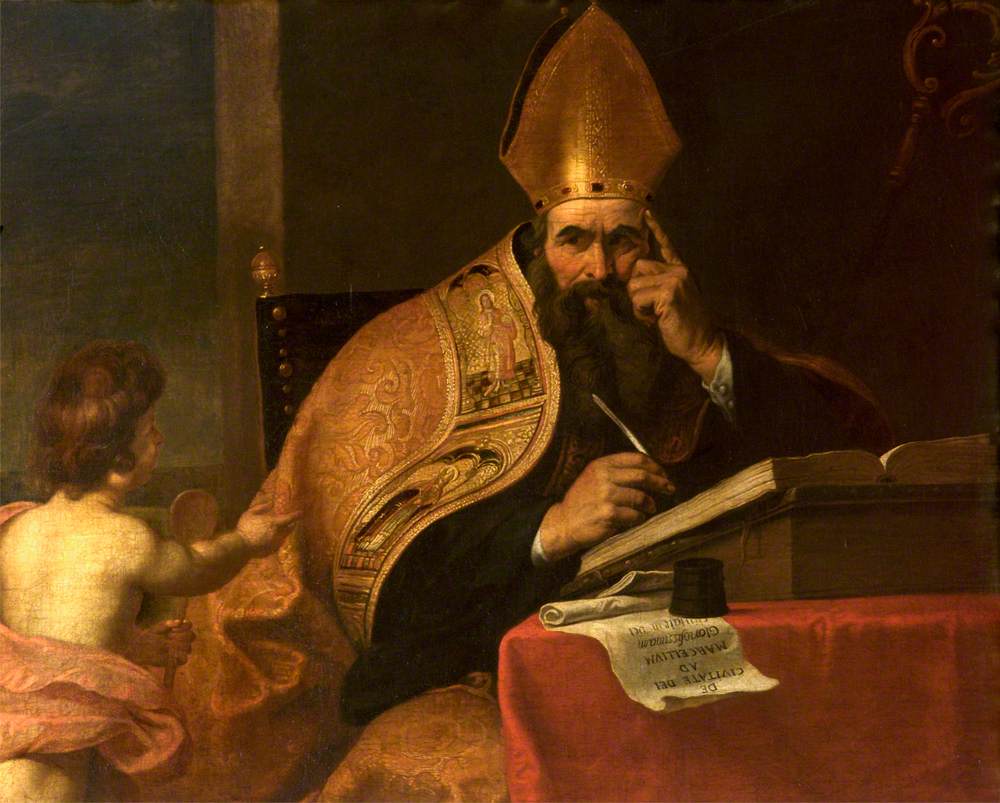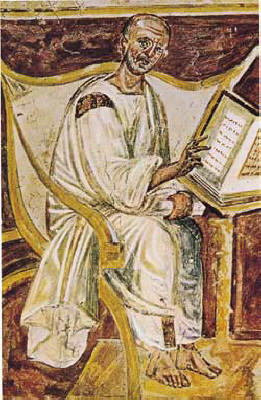Feast of St. Augustine, Monday of the Twenty-first Week in Ordinary Time, Year A: 1 Thes 1:1-5, 8b-10, Mt 23:13-22.
Apart from St. Paul, it’s hard to think of a more pivotal early figure for the Roman Catholic Church than St. Augustine of Hippo. Even in the heady time of the late Patristic Age. Just consider the list of Church Fathers from this period!
-
- Gregory of Nazianzus (329 – c. 390)
- Basil of Caesarea (c. 330 – 379)
- John Chrysostom (347–407)
- Ambrose (A.D. 340–397)
- Jerome (347–420)
- Augustine of Hippo (354–430)

His corpus of writing is immense and highly influential: more than 100 separate titles, including Confessions, City of God, and On Christian Doctrine. It wouldn’t be until St. Thomas Aquinas came along 800 years later that the Western Church would produce such a philosophically deep and theologically important writer.
Any facet of his life or works would serve to occupy us for days at a time. Today, I want to focus on something that might surprise you to discover: St. Augustine wrote the oldest known monastic rule in the Western Church. Yes, 150 years before St. Benedict of Nursia wrote the longer Rule of Saint Benedict, St. Augustine wrote his rule in 397 AD. We might not think of St. Augustine as particularly “monastic.” We might know of his early life as a successful rhetorician and promiscuous Roman gentleman on his way to being a provincial governor. Alternatively, we might recognize that his major vocation was as Bishop of Hippo, a position also not associated with the observance of a rule of common life. But that major turning point in his life when he was stationed in Milan (then, the most powerful seat of the Roman empire) brought him into intimate contact with the strong, orthodox St. Ambrose. He also knew other figures such as the cantankerous St. Jerome, who was translating Greek and Hebrew sources to compile new Latin texts (and picking fights with friends and enemies alike). All three men were successful Roman citizens, dedicated to secular upward mobility until they had their respective conversion moments and adult baptisms. All three men experienced that something electric in the 4th-century air that was appealing to adult converts ready to devote themselves to God. This electricity took the form of ascetical practices like virginity, voluntary poverty and other self-denials that had made their way into Christian minds from the Desert Fathers.
Let’s recall the history of the Church in the 4th century. Under the emperor Diocletian, this century opens with one of the most severe (and final) persecutions of Christians throughout Europe, north Africa, the Levant, and the East. Royal edicts banned Christian worship, confiscated books and sacred vessels, legally destroyed churches, arrested all clergy, released apostates, and made sacrifice to pagan gods compulsory. Christians began the century in the same state of putting their lives on the line for Christ that had occurred sporadically in the previous three centuries. Martyrdom remained the very real standard for which Christians strived.
But then along comes Emperor Constantine who surprises everyone. Christianity is made legal by the Edict of Milan in 313 and Constantine is the one who convenes the Council of Nicea in 325 to get the 1,800 bishops to agree upon and articulate their official doctrine. Imagine going from underground house churches to formal, state-sanctioned religion in the matter of a few decades. Christians who saw themselves as ready at any moment to sacrifice their lives for Christ were now surrounded by an influx of new Christians who saw it as a safe and sanctioned religion. As Henri Marrou writes in The Christian Centuries: The First Six Hundred Years, “From the spiritual point of view, of course, this progress was not wholly beneficial. The calm enjoyed by the Church deprived it of the sieve of martyrdom and on the whole lowered the quality of recruits; there is evidence of contamination, compromise, and some infiltration from the surrounding paganism, and we are no longer aware of the early fervor of the Church of Saints” (226).
It’s no wonder that the next several hundred years were very concerned with rooting out heresies.

While the martyr-as-model became a rarity, the Holy Spirit had been building a new model of Christian life: the monastic. In the second half of the previous century (the late 200s), men and women began to voluntarily remove themselves from “civilized life” to the desert just outside the cities in Egypt and later the middle east. These early monastics, sometimes completely alone, sometimes in loose communities, pursued a life more “pure,” away from the temptations and irrelevancies of secular life. Their personal habits ranged from severely to loosely ascetical. Christianity found a new role model in the desert monastics.
By the time St. Anthony the Great (the “founder of desert monasticism” although not the first) dies in 356, thousands of monks and nuns were flocking to the deserts for this lifestyle. And by the time Jerome, Ambrose, and Augustine were being baptized (respectively, 365-ish, 374, and 387 AD), the monastic lifestyle was widely upheld as the new standard of Christian behavior. All of this explains why Augustine developed his Rule in 397 – it was his ideal to continue to live in community with like-minded Christian men.
The Rule of Saint Augustine clearly holds up the early Apostolic Church as the model for living in an intentional community. As it states, “The primary reason for your sharing life together is to live harmoniously in the house and to have one heart and one soul in seeking God. Do not call anything your own; possess everything in common … For thus you read in the Acts of the Apostles, that all things were held in common among them, and distribution was made to each one as needed” (from the text received by the Order of Preachers, as appears in the second reading of today’s Office of the Readings according to the Propers for the Order of Preachers). Thus, Christians have a lineage from apostle to martyr to monastic.
A thousand years later, St. Augustine’s rule was just as important as St. Benedict’s. By the fifteenth century there were over 4,500 houses in Europe following the rule (from The HarperCollins Encyclopedia of Catholicism). Of particular interest to me, St. Dominic chose the Rule of Saint Augustine as the rule for his newly formed Order of Preachers. This shouldn’t surprise us since Dominic was drawn to the same Apostolic mission that appealed to St. Augustine: living simply in accord with one another while preaching the Gospel. In today’s Office of the Readings according to the Propers for the Order of Preachers, Blessed Humbert of Romans (fifth Master General of the Order of Preachers, 1254-1263) tells us how appropriate the rule is for preachers, particularly in its simplicity and emphasis on apostolic life. He writes:
There are many rules that lay down many bodily disciplines. The rule of Saint Augustine consist of more regulations regarding spiritual actions, so that there may be the love of God and neighbor, the unity of hearts, and the harmony of lives. Who does not know that spiritual exercises are more valuable than bodily ones?
So while St. Augustine gives the Church the most thorough synthesis and re-working of Neoplatonism within Christianity, while he gives us incredible understanding and articulation of the Trinity and other supernatural concepts, while he details exacting problems with heresies like Manicheanism and Pelagianism, he holds onto this core of simplicity in the apostolic life. His life shows us that a simple, apostolic way of living puts us on the Way to the Kingdom and reveals to us the treasures of wisdom that God is delighted to give us.

More particular to today’s readings in the Mass, St. Augustine is a thorough foil to the scribes and Pharisees who Jesus warns in the gospel reading. Jesus calls them “blind guides” and “blind fools.” He points to their inability to see the forest through the trees: “And you say, ‘If one swears by the altar, it means nothing, but if one swears by the gift on the altar, one is obligated.’ You blind ones, which is greater, the gift, or the altar that makes the gift sacred?” Jesus is pointing out that in their tiptoeing around their many rules (case in point: do not swear by the Lord’s name), they create ridiculous new rules that have corrupted the very heart of God’s revelation to humanity. How could they ever utter the phrase, “if one swears by the altar, it means nothing”? This is the path of people who have forgotten the truths about God and instead of constantly conforming their hearts to God they conform their lives to a succession of trivial rules they make up to avoid trivial sins.
Jesus strongly states just how off-base they have become: “One who swears by the altar swears by it and all that is upon it; one who swears by the temple swears by it and by him who dwells in it; one who swears by heaven swears by the throne of God and by him who is seated on it.”
At stake in this gospel passage is the concept of taking oaths – that is, declaring one’s commitment to something. The scribes and Pharisees have invented some sayings that exploit loopholes in Jewish strictures, but they’ve completely lost the point along the way. They should know that the first, and really only meaningful oath they take is to God Himself, and the altar and temple are His, not theirs. As Jesus says later in this episode, “You blind guides! You strain out a gnat but swallow a camel!” (Mt 23:24).
Are oaths that important? Absolutely! We receive baptism, we receive our faith, we receive confirmation and the gifts of the Holy Spirit; but at some point God wants us to actively swear our lives to Him. He wants us to stake our lives in Him, to have Him be the basis upon which everything else in life is measured and committed. Thus, if He is the measure of absolute commitment, the seriousness of our oaths and commitments to other things in life can be made in reference to Him.
But doesn’t Jesus tell us elsewhere, “But I say to you, Do not swear at all, either by heaven, for it is the throne of God, or by the earth, for it is his footstool” (Mt 5:34-35a)? St. Augustine himself replies to this when replying in a letter to “Honorable Publica” (thought to be a North African Jew in the process of converting to Christianity). Augustine writes that Jesus’s words are “in my opinion spoken, not because it is a sin to swear a true oath, but because it is a heinous sin to forswear oneself: from which crime our Lord would have us keep at a great distance, when He charged us not to swear at all” (Letter 47, 398 AD). Augustine knows that in the context of commitment to the faith and to each other, oaths serve a very great purpose.
His religious rule continues to elicit oaths of faithfulness to this day, 1600 years later.
So, today I thank God for the life, writings, example, and rule of Saint Augustine. May we continue to plumb the depths of his writings and wisdom throughout our days here on earth and maybe even praise God in heaven alongside him.